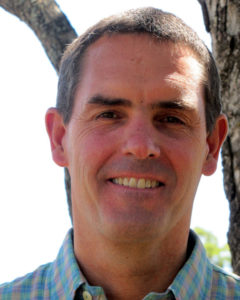Director of Tropical Program

Tim serves as the Director of both the Tropical Program and the Climate Change Program
Tim Tear, Ph.D
Director of Center for Climate Change and Conservation; Director of Tropical Program; Director of Climate Change Program
timothy.tear@briwildlife.org
207-839-7600 x209
Tim has over thirty-five years of experience directing and managing conservation programs with organizations such as Wildlife Conservation Society, The Nature Conservancy, and the Frankfurt Zoological Society.
He came to BRI in July 2020 as the International Senior Scientist, overseeing international research and policy priorities with a focus on BRIs Tropical Program, and an emphasis on expanding projects in Africa. Tim will continue to focus on work in Africa and the tropics, and is developing the Climate Change Program, including the development of soil carbon projects in African rangelands. He is also working on mercury contamination as it relates to ASGM activities, biomonitoring, and the Minamata Convention on Mercury.
Education & Certifications
Education
- Ph.D., Forestry, Wildlife, and Range Sciences, University of Idaho (1994)
- M.S., Wildlife Resources, University of Idaho (1992)
- B.S., Environmental Conservation, University of New Hampshire (1983)
Certifications
- Frankfurt Zoological Society, US – 2011 to 2013
- Hudson River Environmental Society – 2002 to 2005
Research Interests
- Integration of Natural Climate Solutions & Ecosystem Services
- Return-on-Investment & Soil Carbon
- Endangered Species, Habitat Restoration & Rewilding
- Community-based Conservation
Books and Book Chapters, Publications
- Tear, T.H., et. al. In Review. A burning question: Can savanna fire management generate enough carbon revenue to help save the lion from extinction? One Earth
- Tear, T., and S. Nampindo. 2020. Conservation Reliance in Africa: Uganda and the Ishasha Lions as a window to the future. In “Shepherding Nature: The Challenge of Conservation Resilience.” J.M. Scott, J.A. Wiens, B. Van Horne, and D.D. Goble (eds.). Cambridge University Press, Cambridge, UK. 350 pp.
- Padgett. W., Schrader, B., Manning, M., and T. Tear. 2013. Development and application of historical ecology concepts and assessments in land management and conservation. Pages 19-28 in “Historical environmental variation in conservation and natural resource management: Past, present, and future.” J. Wiens, C. Regan, G. Hayward, and H. Safford (eds.). Wiley-Blackwell, Washington DC.
- Scott, J.M, and T.H. Tear. 2008. What are we conserving? Establishing multi-scale conservation goals and objectives in the face of global threats. Pages 494-510 in “New Approaches to Landscape Ecology” Lindenmayer (editor). Australia.
- Tear, T.H. 2007. Atmospheric Deposition and Conservation: What is the role for conservation organizations? Pages 291-307 in “Acid in the Environment: Lessons Learned and Future Prospects” eds. G.R. Visgilio and D.M. Whitelaw. Springer Science+Business Media, Boston MA.
- Tear, T.H. 2006. Nitrogen deposition and forest degradation. McGraw Hill Yearbook of Science and Technology – 2006. Pages 208-210. McGraw-Hill, New York.
- Gordon, D.R., J.D. Parrish, D.W. Salzer, T.H. Tear, B. Pace-Aldana. 2006. The Nature Conservancy’s Approach to Measuring Biodiversity Status and the Effectiveness of Conservation Strategies. Pages 688-694 In Principles of Conservation Biology, Third Edition. Eds. Groom, M.J., G.K. Meffe, and C.R. Carroll. Sinauer Associates, Sunderland MA.
- Kareiva P., T.H. Tear, S. Solie, M. Brown, L. Sotomayor. 2005. Nongovernmental Organizations. Pages 176-191. In D.D. Goble, J.M. Scott, and F.W. Davis, eds. The Endangered Species Act at 30. Island Press, Washington, DC.
- Daly, R.H., M.D. Gallagher, P.N. Munton, and T.H. Tear. 1997. Status and distribution of Caprinae by region: Oman. Pages 65-70 in D.M. Shackleton, editor and compiler. Wild sheep and goats and their relatives: Status survey and conservation action plan for Caprinae. IUCN, Gland, Switzerland.
- Scott, J.M., T.H. Tear, and F. Davis (editors). 1996. Gap Analysis: A landscape approach to biodiversity planning. The American Society for Photogrammetry and Remote Sensing, Bethesda, MD. 320 pages.
- Forester, D.J., and T.H. Tear. 1995. Using GIS to model Arabian oryx habitat quality and use: a preliminary analysis. Pages 662-666 in J.A. Bissonette and P.R. Krausman, editors. Integrating people and wildlife for a sustainable future. Proceedings of the First International Wildlife Management Congress. The Wildlife Society, Bethesda, MD.
Journal Articles
Reserach Reports
Grants, Awards & Fellowships
- 100 Leaders from the College of Natural Resources. University of Idaho – Celebrating 100 years of Natural Resources 1917-2018. 2018.
- Leadership at an important time of transition in New York – The Nature Conservancy – 2012
- Leadership of Conservation Action Teams in New York – The Nature Conservancy – 2010
- Alumni Achievement Award – University of Idaho, College of Natural Resources – 2004
- Graduate Student of the Year – University of Idaho, College of Forestry, Wildlife & Range Sciences – 1994
- First Place – University of Idaho Graduate Student Research Competition, Natural & Agricultural Sciences – Plants & Animals Division – 1994
- Alumni Award for Conservation – National Outdoor Leadership School (N.O.L.S.) – 1992


